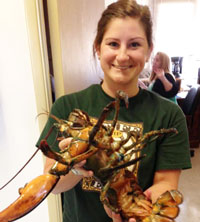
Name: Megan Mudron
Education: B.S. in Marine Science and B.S. in Biology at Coastal Carolina University; Masters of Science in Zoology at Colorado State University
Hometown: Bishopville, Maryland
Career goal: Teach biology at a high school level before working at a community college or university.
Favorite Memory: Working in the Crab Lab during the summer with both graduate students and undergraduates. “It’s more fun, there’s a little less stress going through all these experiments and getting the tissues we need and so on,” Megan explains. “It’s nice, it’s kind of a family.”
Project: Myostatin and mTOR expression in the blackback land crab, Gecarcinus lateralis, after molt cycle manipulation
Megan works on a grant to look at gene expression during the crustacean molt cycle. She looks at which genes drive crabs to either stop molting or continue molting, which will help scientists understand how crabs control growth.
Crabs exist in a stage of molting called intermolt for most of their lives. When they begin to molt, they enter a stage called premolt, where genes begin to change to prepare the animal to shed its shell and grow a new one. At the beginning of premolt, crabs can stop molting if they sustain injuries or feel threatened, but after a certain stage they become committed and must see molting through to the end.
The study stimulates crabs to begin molting and looks at how protein levels change during the molt cycle. Megan isolates a protein found throughout a crab’s body called Myostatin, which regulates the growth of muscle tissues. The Myostatin plays a huge role in regulation during a crab’s commitment stage. She also works with another chemical, rapamycin, that can prevent the gene mTOR from activating the beginning of molting. Using rapamycin delays molting for a few days. These experiments allow Megan to see how each affects crab molting.
Gene response of Carcinus maenas, the green shore crab, after an acute temperature stress
Megan also explores how stress affects the invasive green shore crabs on a gene expression level to see how changes in the ocean due to global warming could affect the crab population. She received a travel grant to work at the UC Davis Bodega Marine Laboratory, one of CSU’s partner labs. She collected the crabs at a nearby harbor and used specialized temperature chambers to test the crabs' stress levels. Megan examines the crustaceans’ responses to temperature and hypoxia, or oxygen deprivation, by looking at levels of AMP-kinase, an enzyme and stress indicator. Scientists can see high levels of AMP-kinase and conclude that a crab feels stress. “My guess is that they’re so invasive that they’re going to have a very small response to this temperature stress,” Megan hypothesizes.
